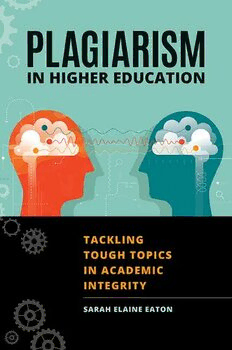
Plagiarism in Higher Education: Tackling Tough Topics in Academic Integrity PDF
Preview Plagiarism in Higher Education: Tackling Tough Topics in Academic Integrity
Plagiarism in Higher Education This page intentionally left blank Plagiarism in Higher Education TACKLING TOUGH TOPICS IN ACADEMIC INTEGRITY Sarah Elaine Eaton Copyright © 2021 by Sarah Elaine Eaton All rights reserved. No part of this publication may be reproduced, stored in a retrieval system, or transmitted, in any form or by any means, electronic, mechanical, photocopying, recording, or other wise, except for the inclusion of brief quotations in a review, without prior permission in writing from the publisher. Library of Congress Cataloging- in- Publication Data Names: Eaton, Sarah Elaine, author. Title: Plagiarism in higher education : tackling tough topics in academic integrity / Sarah Elaine Eaton. Description: Santa Barbara, California : Libraries Unlimited, 2021. | Includes bibliographical references and index. Identifiers: LCCN 2020040794 (print) | LCCN 2020040795 (ebook) | ISBN 9781440874376 (paperback) | ISBN 9781440874383 (ebook) Subjects: LCSH: Plagiarism. | Education, Higher—Moral and ethical aspects. | College teachers—Professional ethics. Classification: LCC PN167 .E28 2021 (print) | LCC PN167 (ebook) | DDC 808.06/6378—dc23 LC record available at https://lccn.loc.gov/2020040794 LC ebook record available at https://lccn.loc.gov/2020040795 ISBN: 978-1-4408-7437-6 (print) 978-1-4408-7438-3 (ebook) 25 24 23 22 21 1 2 3 4 5 This book is also available as an eBook. Libraries Unlimited An Imprint of ABC- CLIO, LLC ABC-C LIO, LLC 147 Castilian Drive Santa Barbara, California 93117 www . abc - clio . com This book is printed on acid- free paper Manufactured in the United States of Amer i ca As I was writing this book, my friend and mentor, Dr. Tracey Bretag, was encouraging me every step of the way. The book went into production just before she passed away. We carry on our work and our commitment to academic integrity in her absence, inspired by her commitment to ethical teaching, learning, and living. This page intentionally left blank Contents Preface ix Acknowle dgments xiii Introduction xv Chapter 1 A Brief History of Plagiarism 1 Chapter 2 Contextualizing and Defining Plagiarism in Higher Education 14 Chapter 3 Intentionality, Textuality, and Other Complicating Factors 37 Chapter 4 A Multistakeholder Systems Approach to Plagiarism: The 4M Framework 58 Chapter 5 Evaluation and Assessment 84 Chapter 6 Self- Plagiarism 101 Chapter 7 Academic File Sharing: Sharing Is Caring, and Other Myths 112 Chapter 8 Contract Cheating: Outsourced Academic Work 131 vii viii Contents Chapter 9 Diversity, Equity, and Inclusion 153 Chapter 10 Recognizing, Reporting, and Resolving Plagiarism 170 Chapter 11 Plagiarism by Professors and Researchers 195 Chapter 12 Conclusion: Contemplating the F uture of Plagiarism 211 Index 227 Preface The pro cess of writing a book begins long before the first words are ever typed. At least, that’s how it has been for me. I suppose my obsession with citing, referencing, and source attribution began when I was a doctoral student. My PhD supervisor, Dr. J. Tim Goddard, had a par tic u lar way of teaching his gradu ate students how to do a lit er a ture review, which I have not seen written down anywhere before or since. He would tell us, “Imag- ine you are coming to a conversation circle where p eople are talking about your subject. The conversation has been going on for many years, maybe even centuries. The p eople who are in this circle can be from any point in history. When you join the circle, you sit down and listen to the voices of those who have come before you. Listen closely to what they have to say, and try to understand their point of view. Then pay attention to the rela- tionship between the people in the circle. Who wrote on the topic first? Who influenced whom? Who disagrees with whom, and why? How has the conversation shifted over time? What have people been saying recently? Your job when you first join this circle is to listen, and to understand. In time, you will contribute your own voice to the conversation, but you d on’t start by talking. You start by listening” (T. Goddard, oral teachings. Mul- tiple dates from 2005 onward). Of course, by “listen,” he meant “read.” Originally from the north of England, Tim’s career was deeply affected by working with Indigenous populations in a number of countries. His way of teaching us how to understand and undertake a lit er a ture review was no doubt influenced by Indigenous perspectives and teachings. It was based on the sacred tradition of sharing circles in Indigenous cultures. Tim’s approach focused on p eople and relationship- building. He taught us that starting with the sources first was backward. He was insistent that people write the books and journal articles that we read and cite, and so we must start with the p eople, rather than with the sources. Tim’s approach ix
